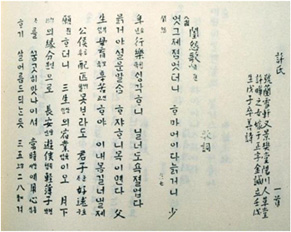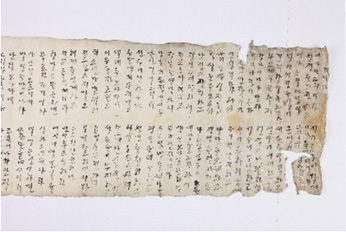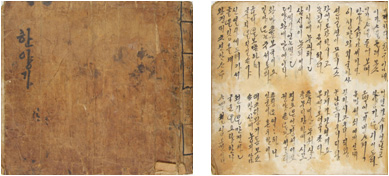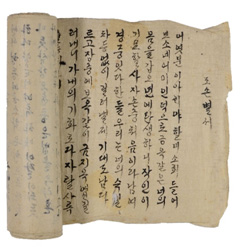Overview
Self-expression and historical response of the marginalized
Naebang-gasa has been created since the 16th century and continues to be created and enjoyed today. However, its genuine enjoyment and transmission was considered to be from the 19th to 20th centuries. This was an era of important transition in terms of world history. First of all, it was a period to realize the modern society by overcoming pre-modern elements, and a period where expansion of imperialism and opposition of colonies conflicted with one another. Naebang-gasa has important world history values in that it demonstrated the aspect of self-expression and social challenges, especially that of those who were marginalized and oppressed during this period of transition.
Naebang-gasa contains the process by which women express themselves and secure their identity. The record of women in human history began primarily with the writing of enlightenment and education for women. This was largely led by upper class male intellectuals. Therefore, the results of writing and recording as self-expression by women themselves were difficult to find even before and after modern times.
Naebang-gasa started from the 16th century <Gyuwonga> through women's self-expression and expressed accusations of medieval era order based on the speech manner of lamentation. Even <Gyenyeoga>, which began with the discourse of women's enlightenment and education, freely portrays women who want to escape from the male-centered ideology through continuous production of different versions. An important characteristic of this differentiation is the expansion of one's narration.
 <Gyuwonga> ⓒTHE ACADEMY OF KOREAN STUDIES
<Gyuwonga> ⓒTHE ACADEMY OF KOREAN STUDIES
 <Gyenyeoga>
In this way, Naebang-gasa has a significant meaning in terms of writing and its record in which women became subjects to express themselves and heal themselves. Moreover, the meaning is even greater when we recall that the main location of transmission of Naebang-gasa is Andong of Yeongnam. Andong is the most deeply rooted area of male-centered Confucianism. It is a unique value of Naebang-gasa that women resolutely expressed and recorded their voices in these areas. It is noteworthy that these records have been transmitted and accumulated in the location with the strongest Confucian ideology since the medieval era.
<Gyenyeoga>
In this way, Naebang-gasa has a significant meaning in terms of writing and its record in which women became subjects to express themselves and heal themselves. Moreover, the meaning is even greater when we recall that the main location of transmission of Naebang-gasa is Andong of Yeongnam. Andong is the most deeply rooted area of male-centered Confucianism. It is a unique value of Naebang-gasa that women resolutely expressed and recorded their voices in these areas. It is noteworthy that these records have been transmitted and accumulated in the location with the strongest Confucian ideology since the medieval era.
Meanwhile, Naebang-gasa is a documentary heritage that contains women's perception of reality and the spirit of the times. From the perspective of world history, women have always been the focus of attention when the nation is in crisis or in times of social change. Only the role of women as mother and wife was emphasized, and their duties became significant. Yet women were never in a position to lead the discourse of the times. The same applies to the modern times of Korea. However, a record of women's interest in history and social perceptions can be frequently found in Naebang-gasa.
The interest in the creation and enjoyers of Naebang-gasa was not created by themselves, but was based on the fact that they enjoyed reading and transcribing lyrics such as <Yeokdaega> types or <Hanyang 500 Years Song>, which dealt with the history of China and Joseon. <Hanyang 500 Years Song> became popular with women too, especially during the Japanese colonial period, when the different versions gradually expanded and widened the scope of enjoyment. This is meaningful to show that women of the time continued their active interest in history and social obligations through Naebang-gasa. This is because based on this, women were able to create lyrics that talk about history and reflect on themselves in history.
 <Hanyang 500 Years Song> ⓒ National Hangeul Museum
In the first half of the 19th and 20th centuries, when Naebang-gasa was actively transmitted, Korea had to endure the double predicaments of national usurpation and transition to the modern times. In this situation, Naebang-gasa records women's social perception of reality and the spirit of the times. This is the case of the lyrics of Manchurian exile during the Japanese colonial period. Here, women's lamentation in the historical context of Japanese oppression and exile in Manchuria appeared in the social direction. In particular, the Manchurian exile lyrics were directly created by women belonging to Andong's prestigious families, which portrays the pain and lament that one's own family experienced in exile in Manchuria and continued the independence movement. Kim Woo-rak's (1854~1877) <Ganunso> and <Josonbyeolseo>, and Lee Dong's <Ni Yeosa Geukkeun Yeokso>, that wrote the experience of the modern-day cataclysm are representative.
<Hanyang 500 Years Song> ⓒ National Hangeul Museum
In the first half of the 19th and 20th centuries, when Naebang-gasa was actively transmitted, Korea had to endure the double predicaments of national usurpation and transition to the modern times. In this situation, Naebang-gasa records women's social perception of reality and the spirit of the times. This is the case of the lyrics of Manchurian exile during the Japanese colonial period. Here, women's lamentation in the historical context of Japanese oppression and exile in Manchuria appeared in the social direction. In particular, the Manchurian exile lyrics were directly created by women belonging to Andong's prestigious families, which portrays the pain and lament that one's own family experienced in exile in Manchuria and continued the independence movement. Kim Woo-rak's (1854~1877) <Ganunso> and <Josonbyeolseo>, and Lee Dong's <Ni Yeosa Geukkeun Yeokso>, that wrote the experience of the modern-day cataclysm are representative.
 <Josonbyeolseo>
Women, who were the creators of Naebang-gasa, have never neglected their social perceptions and challenges to the crisis and social transformation of the nation. Rather, they showed that they have become an active recorder without evading their historical mission. Naebang-gasa is of great value in that they represent the interests of women in history, their responsibilities, and their mission. In particular, this record is especially important as a historical testimony that directly bears witness to Korea's modern and contemporary history.
<Josonbyeolseo>
Women, who were the creators of Naebang-gasa, have never neglected their social perceptions and challenges to the crisis and social transformation of the nation. Rather, they showed that they have become an active recorder without evading their historical mission. Naebang-gasa is of great value in that they represent the interests of women in history, their responsibilities, and their mission. In particular, this record is especially important as a historical testimony that directly bears witness to Korea's modern and contemporary history.
Consequently, it was confirmed that the result of the women's self-expression, securing their identity and gaining interest in history as subjects of history was Naebang-gasa. Naebang-gasa is an important record that concretely displays the representative signs of the transition period of the world history from the 19th century to the 20th century when medieval world outlook was beings transformed into modern values.
Naebang-gasa contains the process by which women express themselves and secure their identity. The record of women in human history began primarily with the writing of enlightenment and education for women. This was largely led by upper class male intellectuals. Therefore, the results of writing and recording as self-expression by women themselves were difficult to find even before and after modern times.
Naebang-gasa started from the 16th century <Gyuwonga> through women's self-expression and expressed accusations of medieval era order based on the speech manner of lamentation. Even <Gyenyeoga>, which began with the discourse of women's enlightenment and education, freely portrays women who want to escape from the male-centered ideology through continuous production of different versions. An important characteristic of this differentiation is the expansion of one's narration.


Meanwhile, Naebang-gasa is a documentary heritage that contains women's perception of reality and the spirit of the times. From the perspective of world history, women have always been the focus of attention when the nation is in crisis or in times of social change. Only the role of women as mother and wife was emphasized, and their duties became significant. Yet women were never in a position to lead the discourse of the times. The same applies to the modern times of Korea. However, a record of women's interest in history and social perceptions can be frequently found in Naebang-gasa.
The interest in the creation and enjoyers of Naebang-gasa was not created by themselves, but was based on the fact that they enjoyed reading and transcribing lyrics such as <Yeokdaega> types or <Hanyang 500 Years Song>, which dealt with the history of China and Joseon. <Hanyang 500 Years Song> became popular with women too, especially during the Japanese colonial period, when the different versions gradually expanded and widened the scope of enjoyment. This is meaningful to show that women of the time continued their active interest in history and social obligations through Naebang-gasa. This is because based on this, women were able to create lyrics that talk about history and reflect on themselves in history.


Consequently, it was confirmed that the result of the women's self-expression, securing their identity and gaining interest in history as subjects of history was Naebang-gasa. Naebang-gasa is an important record that concretely displays the representative signs of the transition period of the world history from the 19th century to the 20th century when medieval world outlook was beings transformed into modern values.


